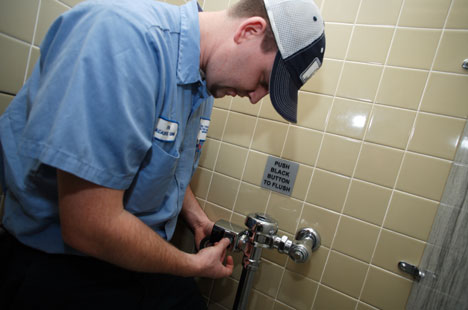Fewer Flushes, More Conservation
FMD goes across campus to switch autoflush toilets

Kevin Brinn is among the mechanics and plumbers on a mission at Duke. His task: Evaluate whether sensors on automatic flush toilets can be adjusted to manual to save water.
He was working in restrooms in the Divinity School this week, covering sensors with electrical tape and posting signs with instructions to "push the black button" for manual flushing.
"I'm hopeful this will help save water and cut back on calls we get from people on campus, complaining that automatic flushers are annoying because sometimes they flush more than once," said Brinn, 27, a general maintenance mechanic with Duke's Facilities Management Department, as he stretched tape over a sensor in the Gray Building.
With Durham moving to Stage IV restrictions, Duke continues to make operational changes and facilities improvements to reduce water consumption.
One of the most noticeable changes -- adjusting automatic flush toilets to manual mechanisms -- stemmed from recommendations from the Duke community through Duke's new water conservation website. By adjusting automatic flush toilets to manual, where possible, Duke hopes to save thousands of gallons daily.
"Auto flush units and manual operated fixtures use the same amount of water," said Jack Burgess, assistant director of maintenance services in Duke's Facilities Management Department (FMD). "But some auto flush units, especially the type mounted on the side of the tank, have a tendency to flush more than once because of their sensitivity to motion. This can activate the sensor and cause multiple flushes."
During the past two weeks, FMD plumbers and mechanics have used black electrical tape to cover sensors on dozens of automatic toilets in buildings such as Duke Divinity School. Similar changes are underway at health system facilities.
"Covering the sensor with tape is a short term solution to prevent an automatic toilet from flushing when it isn't needed," Burgess said. "We are evaluating other options, such as installing a new dual-flush handle mechanism. Dual-flush handles can be used in the conventional way or can by pushed up, resulting in further reduction in water usage."
Many auto flush toilets on campus can now be flushed by pushing a manual override button that was incorporated into the factory design.
The adjustment is welcomed by Duke community members.
"There have been times when I was in a stall and the automatic toilet flushed so many times that I lost count," said Gail Chappell, 61, a faculty secretary at Duke Divinity School. "About six months ago, we reported one in the Gray Building that had gone haywire and kept flushing. A maintenance worker came out and fixed it. I'm glad that they're switching them to manual now because I'm really worried about the water crisis. I've lived in Durham my entire life and I've never seen a water shortage like this before."
Duke began installing automatic flush toilets about a decade ago to improve sanitation and decrease maintenance problems that existed with manual operated toilets.
"A lot of people don't like to touch the toilet handle, and in some cases people were using their feet to flush, which resulted in a lot of leaks around the handles," Burgess said. "We had to fix them, which added up quickly in repair costs. We're hoping that switching the auto flush toilets to manual will add up in another way -- water savings."
Switching to manual flushing was one of the most common tips submitted in recent weeks to Duke's water conservation website. Nearly 200 tips were posted by Duke faculty, staff and students students, faculty and staff in the two days that followed President Richard H. Brodhead's Nov. 12 e-mail to the Duke community urging a team approach to water conservation efforts.
Divinity School student Brian Sigmon was among the Duke community members who submitted a suggestion about switching to manual flush. He said he is pleased with Duke's response.
"Seeing the change happen so soon after I submitted my suggestion really made me feel like Duke truly was open to suggestions for conserving water," said Sigmon, 24.
Duke's maintenance crews will continue to fine-tune auto flush toilets, which operate by using an infrared proximity sensor. If a person moves out of the sensor's path for several seconds, the toilet flushes. Sometimes they flush more than once, if a person bends down to get a purse or backpack.
The sensors are located at either the top or side of the toilet. Taping the sensors appears to work on toilets with top-mounted mechanisms, Burgess said, but toilets with side sensors pose a challenge.
"We discovered that people were removing the tape on the toilets with the side sensors," Burgess said.
To help solve that problem, toilets with side sensors will be retrofitted with dual-flush handles, which will allow an option of using up to 1.6 gallons of water. FMD will begin installing dual-flush handles in other buildings such as the Fitzpatrick Center for Interdisciplinary Engineering, Medicine and Applied Sciences (FCIEMAS) in the next few weeks.
Other water conservation suggestions submitted through the website are being analyzed by Duke's water management group, which is chaired by Kemel Dawkins, vice president for Campus Services.